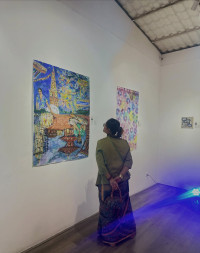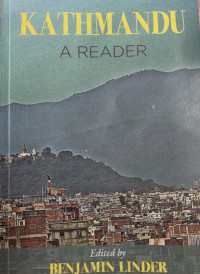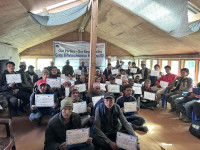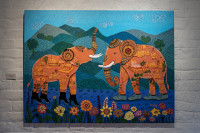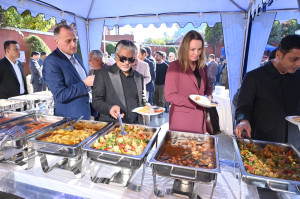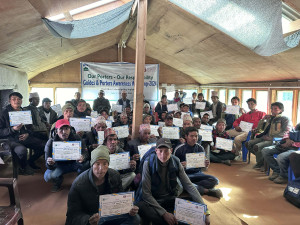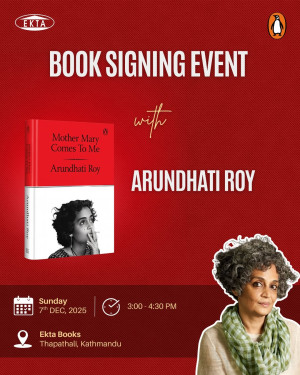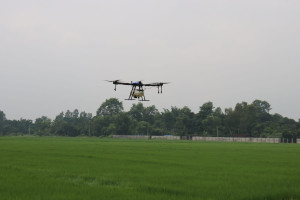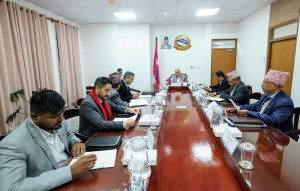Culture & Lifestyle
An ode to Tharu culture and heritage
‘Daule Daule’ exhibition at Patan Museum captures the suppressed history and vibrant culture of one of Nepal’s oldest indigenous groups.
Aarati Ray
Upon entering the multimedia exhibition ‘Daule Daule’ in Patan Museum, visitors will find a note by Erendina Delgadillo, associate curator of history, USA, that says, “History is a battleground of memory. The facts, people, and events societies remember are often chosen by people in power. Telling a full history is one way to remedy past, present, and future inquiry.”
This sets the tone for ‘Daule Daule’, reminding visitors of the importance of understanding the suppressed history and culture of the Tharu community. It highlights how Tharus have been oppressed and ignored in Nepal, making it crucial to pay attention to their stories, culture, and way of life.
Under the Muluki Ain of 1854, Tharu individuals were classified as “paani chalne masinya matwali”, legally designated as touchable and enslavable. This law made them vulnerable to exploitation. Over time, many Tharu individuals were forced out of their homes and lands.
Subsequent events such as the US-funded malaria eradication campaign in the 1960s, the migration of mountain dwellers into Tharu territories, and the Maoist conflict further disrupted Tharu lives. These experiences have had lasting effects on the Tharu community, and researchers have studied these impacts closely.
Even though research has been conducted on Tharu cultural heritage, as Delgadillo pointed out, those in power often control how history is told, resulting in an incomplete representation of the Tharu people’s past. Additionally, since most researchers are not Tharu themselves, their cultural heritage is often overlooked or inaccurately portrayed in popular stories.
The Tharu community, the oldest and largest indigenous community in Nepal’s southern plains, has a wealth of traditions and wisdom passed down through generations. However, their story has often been overlooked by external perspectives.
‘Daule Daule’ seeks to rewrite this misrepresentative narrative and bring forward true stories, putting the Tharu people at the forefront. The exhibit is a big step in telling the full history of Tharu heritage.
As you walk into the multimedia exhibition, you’ll see many pictures depicting various aspects of Tharu life: farming, making pottery, fishing and involvement in political movements. It evokes a sense of travelling back in time and seeing history come to life.
As I looked at the pictures of Tharu women wearing saris and carrying dhakiya on their heads, and men in dhoti making traditional bags, I felt a rush of emotions. Being from the Madheshi community in the Tarai region, I found a comforting familiarity in their culture, lifestyle and clothing.
Seeing these beautiful pictures displayed proudly on the walls made me think back to my school days when kids like us from the Tharu and Madheshi communities were teased, bullied and discriminated against because of our cultures.
Terms like ‘dhoti’ were used as insults, and even a hint of Maithili or Tharu accents seeping into our Nepali speech was met with disapproval. I wondered how this exhibition would impact people like me who, at one point, learned to downplay everything about their cultures and may have even resented their own identity because of the way we were treated.
The exhibition mainly features three things: pictures showing the Tharu people’s way of life, their culture and the role of Tharu women. You’ll see images like a Tharu man making chitwa (bamboo basket) from bamboo in Goberdiha Village, Dang, another man ploughing his field in Saptari, and Tharu women preparing rice seedlings in Khairahani, Chitwan in 1968.
There are also pictures of Tharu women grinding cereals using a traditional grinder in 1972, Tharu porters carrying goods on poles from Tarigaon airport to Ghorahi in Dang Valley in 1966, and a Tharu mother and daughter returning to their village with firewood. These pictures highlight the daily life of the Tharu people. Additionally, you’ll see images of wooden deities placed in villages, showing that the Tharu did not build temples.
Apart from images of individuals working, there are also pictures of a large grain storage built high off the ground in Chitwan in 1968. This demonstrates how the Tharu community used skilled methods to protect their rice from rats and rhinos. Similarly, there are beautiful Tharu wall paintings with patterns of flowers and peacocks, showcasing the rich artistic culture of the community.
You’ll also see pictures of canoes in rivers and Tharu men returning after herding buffalo through muddy waters in the Rapti River. Additionally, there’s a picture of a kharahi, a structure built in open fields to store paddy after harvesting and before threshing, which highlights the close relationship between the indigenous Tharu people and nature.
Through compelling imagery and engaging storytelling, ‘Daule Daule’ shows the diverse roles of Tharu women—from weaving intricate patterns and making dhakiya and pottery to doing household chores, gathering firewood and planting rice.
It also highlights how they lead grassroots and political movements. The exhibition challenges stereotypes about Tharu women, showing them as strong and active individuals, not just passive symbols of beauty.
We often see images of young Tharu women dressed up with makeup and jewellery, but we rarely see the reality of older women with weathered faces and rough hands. Some researchers might describe Tharu women as free or incredibly strong, but according to Indu Tharu, one of the exhibition’s curators, their reality is one of persistence, not freedom.
Even though outsiders might think Tharu women working in fields or fishing are free, it’s actually a reflection of their struggle to survive. Tharu women often need their husband’s permission for important decisions, like visiting their parents. This shows a big difference between how people perceive Tharu women and what their lives are really like.
The exhibition features images of both young Tharu women adorned with jewellery and older women with rough hands. Particularly striking is a photograph showcasing a Tharu grandmother’s hands adorned with tattoos, symbolising the transmission of knowledge across generations.
The curators underscore the invaluable wisdom held by grandmothers, acquired through generations of experience rather than formal education. This includes expertise in fishing, weaving, pottery, farming, and survival techniques, cultivated through everyday life and ancestral teachings.
Another noteworthy aspect of the exhibition is the curators’ attempt to highlight the role of tharu women in social, political, and grassroots movements. Despite discrimination, they have shown remarkable resilience and determination, playing crucial roles in fighting for justice, rights and cultural preservation.
Koili Devi Tharu’s martyrdom during the Khalihan movement in 1951 (2008 BS) is one such example.
Furthermore, during the Tharuhat Tharuwan Movement, when Tharu men faced heightened risks of repression, Tharu women stepped into leadership roles, leading processions and mobilising communities with unparalleled determination.
Their decision to don traditional attire during protests was not merely symbolic but a deliberate assertion of cultural identity and resistance against oppressive forces.
However, despite their active participation and leadership in political movements, Tharu women often find themselves marginalised within these spaces. They face barriers to assuming leadership roles and are frequently relegated to supporting roles, overshadowed by their male counterparts.
The exhibition goes beyond just documentation; it asks the audience to listen to and support Tharu women’s stories. It calls for the audience to recognise and amplify the voices of Tharu women, ensuring that their struggles and achievements are acknowledged and celebrated in the ongoing fight for justice and equality.
As visitors walk through the aisles of ‘Daule Daule’, they are confronted not only with the beauty of Tharu culture but also with the harsh realities of systemic marginalisation and cultural erasure.
It also sheds light on the looming threats to Tharu heritage, symbolised by the gradual disappearance of traditional skills and artefacts. Quick modernisation and the spread of plastic threaten practices that have been around for a long time, putting at risk the valuable knowledge passed down by Tharu ancestors.
Despite these challenges, there’s hope as people come together to reclaim their stories and build a future where they’re proud of their culture and strong in the face of difficulties.
Exhibitions like ‘Daule Daule’ are vital for indigenous communities like the Tharu, providing spaces for cultural celebration, education and documentation. Through art, these exhibitions not only safeguard indigenous histories but also challenge stereotypes, calling upon all to listen, learn, and stand in solidarity with the Tharu community as they navigate a path towards a future where culture flourishes, and voices resonate amidst persistent marginalisation and erasure.
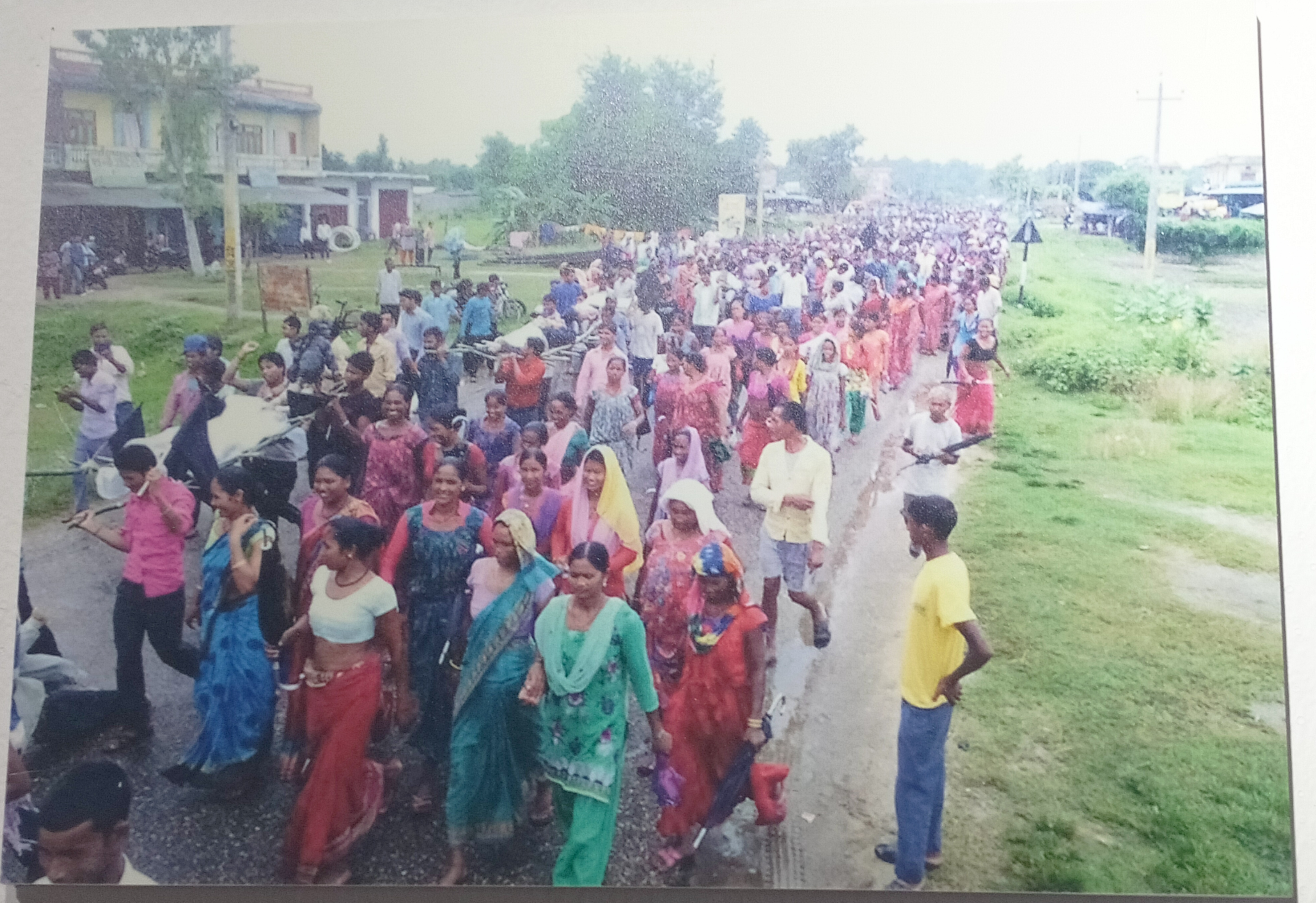
Daule Daule
Curators: Birendra Mahato, Indu Tharu, Sanjib Chaudhary, Lavkant Chaudhary, Arnab Chaudhary, Maria Bossert and Tom Robertson
The exhibition is on display at Patan Museum in Lalitpur, until March 31.




 14.12°C Kathmandu
14.12°C Kathmandu


